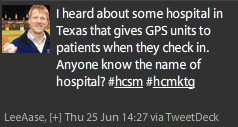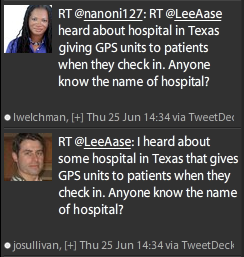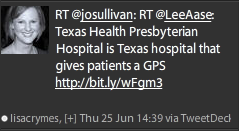On Monday, July 13 from 2-3 p.m. CDT I will be presenting Tweetcamp III (Twitter hashtag #tweetcamp3) as a training session for Mayo Clinic employees.
You are invited to join remotely. I’ll have details on that in a bit. But meanwhile, here is background on the agenda:
- General principles of social media
- The Dinner Party Rule vs. The Law of Large Numbers
- How to avoid being “That Guy”
- Be real and transparent
- Give more than you take
- Integrity
- Mayo Clinic Employee Guidelines
- Understanding Twitter
- Why does it matter?
- How is it different from Facebook, email, long-format blogs and other forms of electronic communication?
- So what can you say in 140 characters anyway?
- Case studies that show Twitter’s potential, or “A Series of Serendipitous Events”
- Listening and connecting
- Real-life meetings
- How Twitter has contributed to Mayo Clinic’s reputation
- Journalist interactions and media stories
- Blogger interactions and resulting posts
- How to Tweet Productively – it’s not an oxymoron
- Understanding #hashtags
- Twitter etiquette and building “Tweet cred”
- Using Twitter with Yammer
- The Twitter API
- Twitter applications for desktop and mobile
- Finding “Tweeps”
- Assignments and Extra Credit
As we have done with previous Tweetcamps, #tweetcamp3 will be open to participation from outside of Mayo. If you would like to join via Webinar, please leave a comment with your name, city and location below. Here’s why:
Leaving your comment here helps to demonstrate the worldwide community connection potential of Twitter. Part of what we do in Tweetcamp is show how practical Twitter is for bringing a community of interest together on short notice. I will be asking people to introduce themselves at the beginning of #Tweetcamp3, but by leaving a blog comment it’s more of a permanent record to which we can refer.
By leaving your comment, you help show the reach of social media in general, and Twitter in particular…and in a forum to which you can refer later, to show your internal doubters what can happen in less than three days, over a weekend, via Twitter.
Check back here for details on how to participate, or follow the #Tweetcamp3 hashtag.
Update: Here’s the link for the Tweetcamp presentation and video Webcast. Go here at 3 p.m. EDT/2 p.m. CDT/Noon PDT to participate live, and join the discussion via Twitter at #tweetcamp3 or by entering the #tweetcamp3 room at Tweetchat.com.
Please do leave a comment below with your attendance plans, though, so we can have a record of the scope of participation.


